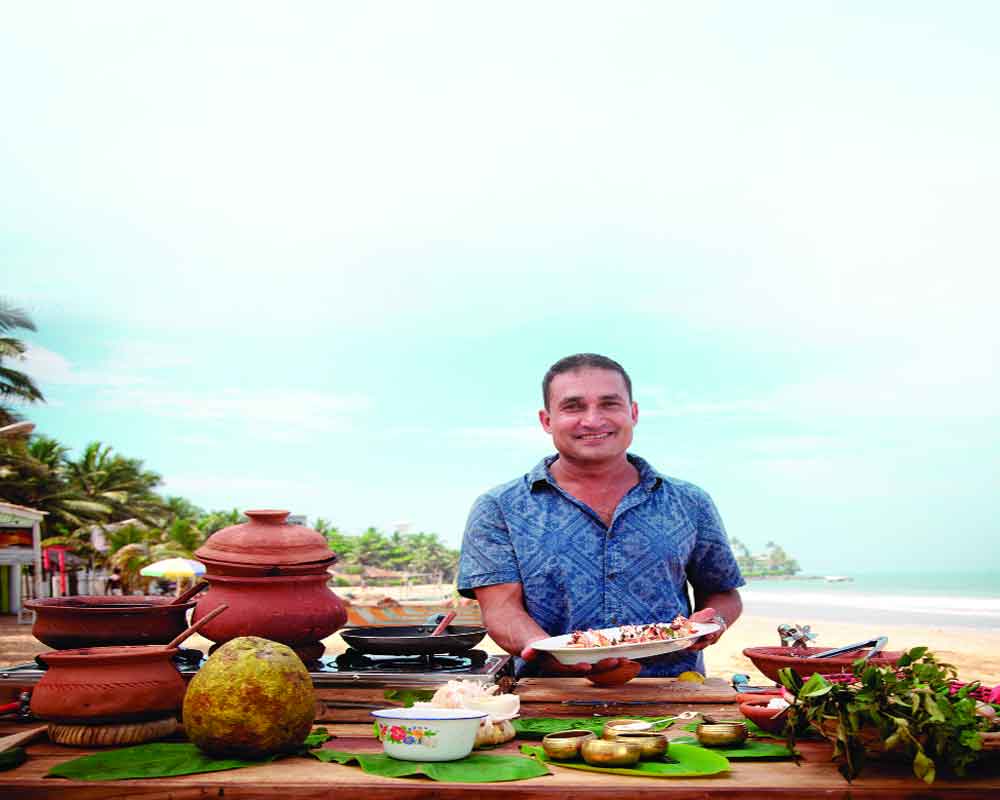An Australian chef of Sri Lankan descent, an advocate of sustainable seafood, author and television presenter Peter Kuruvita tells Ayushi Sharma that because Sri Lanka has been a colony of Portugal, Holland, England and close to Southern India, its cuisine has taken on the best of what was brought to it
Even though it has become a fad to be a vegan these days, you’re still likely to be the odd one out on the dinner table. However, chefs are actually creating a space for them by generating the best alternatives even if it’s not a vegan-friendly cuisine — here, seafood. Chef Peter Kuruvita, too, made sure that there were enough alternatives for the vegetarians on the table as he presented a flavourful island feast of Sri Lankan seafood at Table Stories, a dining concept by FoodInk Expeditions and Roseate Hotels and Resorts.
Food is an effective trigger of profound memories and it’s all about chasing them, believes the chef. Leaving his home in Colombo was one of the toughest decisions that chef Peter took in his life. He often finds himself reminiscing the sights, sound and smell of his home there. And Pol sambhal was one such recipe that has always helped revive that nostalgia. We began the meal with the dish and village bread. The dish, which is a mixture of grated coconut, dried chillies, Maldive fish, lime juice and salt, has forever managed to teleport him back to the village bakery next to his house in Colombo. As a ritual, he would find himself at the bakery every morning picking up a loaf of baked bread, slicing it and placing some Pol sambal into it. He says that it’s a memory he’ll cherish forever. The bread was sleek and crunchy to the core — almost like the crispy, thin-crust of a pizza.
Chef Peter believes that he inherited his passion for cooking from his grandmother. She has undoubtedly been a perennial source of inspiration for him. Her special egg curry was the only reason he would wait for Sundays to come as a child. The sauce that she prepared, brimmed with spices, was the next recipe that he served on the candle-lit dinner table — butter poached crab, sugar snap peas, egg curry and dill. He mixed his grandma’s secret egg curry sauce with sweet-tasting crabs, garnished it with peas, sugar snaps and Wasabi peas to create a dish that was a tribute to her. For vegetarians, it was soybeans, snap peas, kiri hoddy and dill on offer. Except for the Wasabi peas, which were roasted and coated in a mixture of starch, sugar, salt and oil and lemon, it failed to make a mark on my tastebuds.
Moving on, he presented the beetroot curry with pickled red onion, baby target beet, which is an iconic Sri Lankan dish. This curry represented the indomitable spirit of Sri Lankan countrymen. For us to understand how this dish came to be, he told us that he wandered through the markets of Hambantota, a town in Sri Lanka, which was destroyed during the tsunami of 2004. He chose to return there to pay his respect to the people, who never went home and showed how things can be regenerated and recouped after such a tragedy. That’s where he decided to recreate this curry, which is very popular in the country. If you thought beetroot was one of those bland vegetables that was difficult to coax flavour out of, this one by chef Peter was the perfect answer to it.
The next dish needs a background story first. What started in 2003 as an attempt to knock off one of his opponent’s dishes from favourites list, really had chef Peter to create something special. And yet again, his grandmother had a role to play in it. The dish, Sri Lankan snapper curry, aloo chop, tamarind chutney, steamed rice and condiments, was made using her favourite fish curry recipe. To layer this combination, he added beetroot to lend its vivid red colour and the tamarind chutney to up the punch the dish packed. But this chutney wasn’t the one you would traditionally find in the subcontinent. He learnt this particular version from an Indo-Fijian in one of his restaurants in Fiji. He feels that migrants are instrumental in shaping the culinary and cultural fabric of any place. This dish was an amalgamation of chef’s experiences and an ode to all the people he has met in his life. For vegetarians, he replaced the snapper curry with vegetable cutlets and the rest stayed the same. Due to the name, one might recall the usual cutlets one has in Indian homes for breakfast, but these were way beyond conventionality.
Ending the meal on a sweet note, chef Peter presented curds and treacle, for which he had collaborated with the farmers of Sri Lanka. “We made the curd with farmers and palm treacle from the palmyra palm. The combination is undoubtedly heavenly,” he says. This desert was an attempt to bring a smile on the faces of orphans of Hambantota. And it certainly brought a smile on my face, too.
After having a stomach-full of delectable delicacies with many stories and laughter around the table, chef Peter and I sat for a quick conversation over a few glasses of wine.
How did you conceptualise the meal?
The idea was to use the food from my heritage, travel experiences and my restaurant — Noosa Beach House, Australia. I was completely aware that the people of Delhi are not that into seafood. So I purposely chose to present that. It should be fresh, odourless and delicious. So the mission was to seek the highest quality ingredients from the best suppliers available. We achieved that goal with the help of the Table Stories team. I really like to challenge myself in the kitchen. The fusion of Sri Lankan flavours and food at my restaurant is what I did. But I also wanted to bring one Sri Lankan dish as it is and that’s why added the beetroot curry on the menu.
How unique do you find the Sri Lankan cuisine?
Too Indian? I would put it that we are distant cousins, who have grown up in two different countries. Spice-based, coconut-driven, occasionally searingly hot and others are slightly mild. It is heavily influenced by regions and availability, but being a small island, seafood is everywhere. Being a multicultural country, meat is enjoyed in all forms — be it Muslim, Singhalese, Dutch, Portuguese, Burgher or Tamil. We have combined it as one national cuisine. There are so many influences but if you took any of the dishes back to its origin, it would be unrecognisable. As a colony of Portugal, Holland, England and close to Southern India, the cuisine has taken on the best of what was brought to the country, but rather than just adding it onto the menu, the ideas and flavours have been absorbed and become Sri Lankan food. The concept of modern Sri Lanka is very new and for me, it was my French base that helped me to plate the cuisine in a modern style. The idea was to deconstruct the food, ensure all the ingredients are being treated with respect, and then present it in a modern style, while being true to the flavours.
How have you explored various food cultures across the globe?
I get to travel a lot with my job and I love to try everything. In my restaurant, we look at the ingredients rather than the nationality. We are blessed with the most amazing produce in Australia and I like to let the ingredients do the talking. But I focus on how do I use the Australian produce using modern techniques and a twist of Sri Lankan cuisine.
How do you think the Indian audience is accepting the global food trends?
India is being embraced. It has many celebrity chefs and this is a clear indication that the discerning Indian population is now looking for new flavours and textures. India is already ahead of the world — in probably the biggest shift in dining — veganism.
What is your signature dish and how did you come up with such an experiment?
The Sri Lankan snapper curry, tamarind chutney, aloo chop, rice and condiments. In India, when you traditionally eat curry and rice, you have upto six different curries on a plate with condiments, papadum, chilli and pickle. So that was the real challenge — how to serve a single dish and still call it Sri Lankan rice and curry? So here, the first part was to respect the fish because the idea of cooking a curry is to put everything into a pot with spices and cook it. But for me, that process ruined the fish. So I made the curry sauce with the fish scraps and kept the fish fillets aside. Then made a tamarind chutney and used it as the base. I took an idea from a Sri Lankan snack and adapted it to suit the fish curry by adding prawn, sweet potato and a roasted vine-ripened cherry tomato. Later, I added the vegetable component and then served the rice, condiments and coconut sambal separately. For me, being a seafood-orientated chef is that the fish is cooked perfectly and separated from any other flavours.
How do you adapt your dishes to local ingredients while travelling? Any Indian spices or dish that may have caught your fancy?
In India, there are a few ingredients that are not readily available. It is a matter of being organised and ensuring you either order ahead or bring it with you. The Indian spices that are very unique and not used in Sri Lankan at all are — asafoetida, chaat masala, garam masala. Rest is shared but the uses differ.
Food is subjective for different people. Some may like a dish and some won’t. How do you deal with negative criticism to your food?
Take it on the chin and move on. If a guest has chosen a dish from your menu, you know it has to be executed well and if you don’t like it, that is completely fine, they have just chosen the wrong one because as you said, food is subjective for different people, some may like it and some won’t.
I do not let any food below mark leave the kitchen. But if a dish doesn’t make the cut, you go out, talk to the guests and take the comments. Constructive criticism is always good to learn from. Aggressive guests have their own issues, I feel sorry for them and don’t have time for them. If I make a mistake, I own up to it and will probably take it off the bill.


























